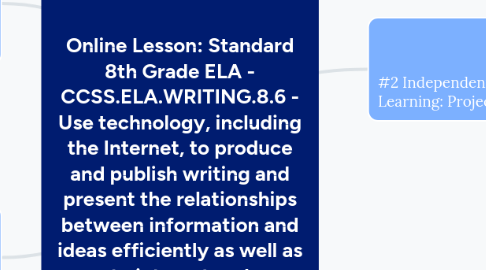
1. #4 Independent/Asynchronous Learning: Project Revison and Finalization
1.1. Based on the feedback given to them by their peers and ChatGPT, students will revise and edit their drafts during asynchronous work time.
1.2. Students will finalize their drafts to present during synchronous class time and submit it to the teacher.
2. #5 Summative Assessment and Feedback
2.1. Students will present their finalized chapter of their Autobiographical Portfolio to the class.
2.2. Students will be evaluated based on the Success Criteria for their medium of choice and feedback will be provided for their areas of strength and areas of improvement by the teacher.
3. #1 Whole Class/Synchronous Learning: Introduction to Project
3.1. Review the Classroom Expectations: All students will engage and particpate in class conversation via speaking aloud, through the chat box, or discussion board.
3.2. Review the Learning Objective: Students will be able to analyze presentation mediums in the Langauge Arts for their advantages and disadvantages for sharing specific details. They will evaluate which mediums will be most ideal for presenting their chapter of their Autobiographical Portfolios on their identity and create a "balance of stories".
3.2.1. APK (Activate Prior Knowledge): Allow students time to think about the types of mediums that exist and what the terms from the Learning Objective mean.
3.2.1.1. Let students use technology to search up terms like "medium," "identity," and "balance of stories" on the Internet to define and find examples of them.
3.2.1.2. Students will participate in a class discussion by discussing their findings to the class by either speaking outloud or entering their findings into the chat box, which will help introverted students contribute to the conversation (Gonzalez, No More Easy Button).
3.3. Review Asynchronous Work Time Assignment: Explain to students that they will have to create a draft of a chapter for their Autobiographical Portfolio. This drafted chapter will be peer-reviewed during synchronous class time.
3.3.1. Use a Jamboard to allow students to submit any questions they have about the drafted chapter or the asynchronous assignment.
4. #2 Independent/Asynchronous Learning: Project Development
4.1. Provide students with examples of Success Criteria Rubics for each medium that they can use to create their own drafted chapter.
4.1.1. Medium examples include: Google Slide, Drawing, Poem, Written Narrative, Video, Song, Photography, Padlet, or a medium of their choice after consulting and being approved by the teacher (Eckert, Getting Back to Basics).
4.2. Provide students with a few examples of chapters with different mediums from my own Autobiographical Portfolio. This will help them get an idea of what they can make for thier own chapter.
4.3. Create a Google Form for students to submit a link to their draft. This Google Form will contain instructions with visuals on how to create an Autobiographical Portfolio folder on Google Drive, which they can make a link to share it with the teacher and later their classmates for peer-review.
5. #3 Collaborative Learning: Project Peer-Review/Feedback
5.1. During synchronous class time, students will each take turns sharing their drafted chapter of their Autobiographical Portfolio in a small group setting. (Kennedy and Rose, The Lessons Learned Online).
5.1.1. Students will be placed in breakout room to share their drafts. While one student is presenting, the others will write down and provide feedback to their peer based on the Success Criteria Rubric for that medium. They can also provide feedback for improvement and what they liked about it.
5.2. Once students return from breakout rooms, there will be a class discussion (students can participate via unmuting themselves or typing in the chat box) on the types of feedback that was given to them and if this peer-review session was helpful or not so that I can get an understanding of where students progress is at.
5.2.1. If I notice student progress is not there yet or there is still confusion, I will open up the floor for students to make suggestions on how I can help further their progress or clarify questions they may have.
5.3. Once class discussion is over, I will tell students to run their draft through ChatGPT and ask it to peer-review and provide feedback (Nichols, Making New Tech Tools).
5.3.1. Afterwards, I will ask students to compare ChatGPT's revision and feedback to that of their classmates from the breakout rooms. I will tell them to look for difference and shortcomings from both (D'Agostino, ChatGPT Advice Academics Can Use Now).
5.3.2. I will provide students with a JamBoard so that they may anonymously submit whose revision and feedback they prefered and why they liked these changes better than the other.
